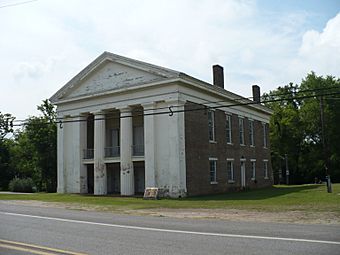Old Marengo County Courthouse facts for kids
Quick facts for kids |
|
|
Old Marengo County Courthouse
|
|

The Old Marengo County Courthouse in 2009.
|
|
| Location | 300 West Cahaba Avenue Linden, Alabama, U.S.A. |
|---|---|
| Built | 1850 |
| Architectural style | Greek Revival |
| NRHP reference No. | 74000426 |
| Added to NRHP | 1974 |
The Old Marengo County Courthouse is a historic building in Linden, Alabama, U.S.A.. It was built in 1850. This building is a great example of Greek Revival architecture, which was a popular style for important buildings back then. It was the third building used as a courthouse for Marengo County, Alabama. A famous event happened here on October 9, 1890. A well-known outlaw named Reuben Houston "Rube" Burrow was involved in a famous incident where he lost his life right outside the building.
Contents
The Story of the Courthouse
Early Buildings
When Marengo became a county in 1818, the first courthouse was a simple log cabin. It was too small for the county's needs! So, on May 25, 1825, the county leaders (called county commissioners) decided to build a new, bigger two-story building. This second courthouse was finished in 1827. It was used until it sadly burned down in 1848.
The 1850 Courthouse
After the fire, the third courthouse was built in 1850. It was put in the same spot as the old one. This new building was used as the main courthouse for a long time, until 1902. There was a short time during Reconstruction (a period after the American Civil War) when the county seat was moved to Demopolis. But then it moved back.
A New Courthouse and New Uses
In 1902, the county leaders decided they needed a much larger courthouse. They also wanted a better location. The main business area of Linden had moved about a mile away. So, a new, bigger courthouse was built. It was a three-story building with a five-story clock tower. This new building was in the Richardsonian Romanesque style.
The old 1850 courthouse then became a public school. In 1915, the Missionary Society of Linden Baptist Church bought the building to use as a church. Later, in 1949, the building was sold to the Veterans of Foreign Wars organization. They used it as a meeting hall. Since the 1960s, the building has mostly been empty and unused.
Pictures of the Courthouse







